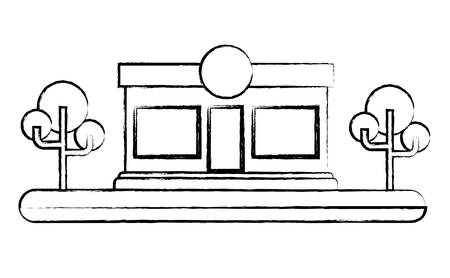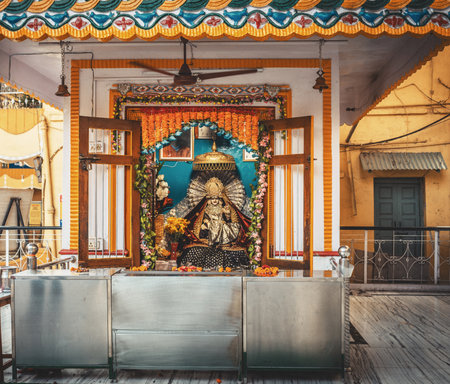Introduction to Traditional Pooja Room Storage
In Indian homes, the pooja room holds a special place, serving as a sacred space dedicated to worship and spiritual connection. Over generations, these spiritual corners have become an integral part of daily life, reflecting family traditions and cultural values. The storage design within a traditional pooja room is not merely functional; it plays a key role in maintaining the sanctity and organisation of this revered area. Each element—be it the arrangement of idols, placement of pooja samagri (ritual items), or safe-keeping of sacred texts—is guided by customs passed down through families and communities. By embracing traditional storage solutions, Indian households ensure that their pooja rooms remain clutter-free, respectful of religious practices, and conducive to daily rituals. This careful balance between practicality and spirituality highlights why thoughtful storage design is so significant in the Indian context.
2. Essential Elements in Pooja Room Storage
When it comes to designing a traditional pooja room in India, understanding the essential elements that need to be stored is crucial. According to Indian customs, a well-organised pooja room not only enhances spiritual ambience but also ensures convenience during daily rituals. Let us explore the must-have items and their storage requirements:
Puja Samagri (Pooja Materials)
Puja samagri refers to all the items required for performing rituals, including incense sticks, camphor, kumkum, turmeric, sandalwood paste, and flowers. These items should be stored systematically in dedicated drawers or containers to maintain cleanliness and accessibility.
Commonly Stored Puja Samagri
| Item | Purpose | Storage Solution |
|---|---|---|
| Kumkum & Turmeric | Used for tilak and offerings | Small jars/trays with lids |
| Incense Sticks & Camphor | Aromatic offering and purification | Airtight boxes/dedicated section in drawer |
| Sandalwood Paste | Applied on idols and devotees | Sealed containers within cabinet |
| Flowers & Garland | Decoration and offering to deities | Baskets or bowls placed on shelves |
Diyas (Lamps) and Aarti Thali (Plates)
Diyas are integral for any Indian pooja, symbolising light and positivity. It is customary to have multiple diyas made from brass, clay, or silver, as well as aarti thalis with all essentials like bell, spoon, and small containers for offerings. These can be neatly organised in lower shelves or pull-out trays for easy access.
Idols and Religious Images
The central focus of any pooja room is the idols or pictures of deities. Traditionally, these are placed at an elevated position on a dedicated platform or mandapam. Ensure there is enough storage space below or beside this platform for additional idols used during festivals or special rituals.
Religious Texts and Scriptures
No pooja room is complete without holy books such as Bhagavad Gita, Ramayana, Hanuman Chalisa, or Guru Granth Sahib. These sacred texts should be respectfully stored on a separate shelf above waist height, ensuring they are protected from dust and moisture.
Quick Reference Table: Pooja Room Storage Essentials
| Storage Area | Items Stored | Best Practices (Indian Customs) |
|---|---|---|
| Main Shelf/Platform | Idols, deity images | Keep uncluttered; avoid placing unrelated objects here |
| Drawers/Trays | Puja samagri (incense, kumkum, etc.) | Categorise by frequency of use; label containers if needed |
| Shelves/Cabinets | Diyas, aarti plates, bells | Store after cleaning; keep oil away from texts/papers |
| Book Shelf (above waist height) | Religious texts/scriptures | Avoid placing directly on floor; cover with cloth if possible |
| Baskets/Bowls (Open Storage) | Flowers & garlands (daily use) | Change regularly; keep dry to avoid odour/moulding issues |
This thoughtful approach to pooja room storage design ensures your space remains both functional and aligned with Indian traditions, enhancing the sanctity of your home’s most spiritual corner.

3. Design Principles Based on Indian Customs
When planning a traditional pooja room storage design in India, it is essential to integrate guidelines that honour both spiritual needs and practical requirements. Storage layout should prioritise easy access to daily pooja essentials like diya oil, incense sticks, kumkum, and holy books. Cabinets or drawers are often placed at waist level for convenience while overhead shelves are reserved for less frequently used items. Material selection plays a crucial role; solid wood such as teak or sheesham is preferred for its durability and auspiciousness, while natural finishes reflect purity and respect for sacred space. Glass and metal accents may be incorporated, but they should not overpower the warmth of wood.
Vastu-Shastra Compliance
According to Vastu Shastra, the ancient Indian science of architecture, pooja room storage must be positioned thoughtfully to attract positive energy. Ideally, cupboards and storage units should be placed on the south or west walls, leaving the north-east corner open for the altar or idol placement. Avoid storing heavy items directly above the deity or mandir as it is considered inauspicious. Furthermore, ensure that all storage units have doors to maintain cleanliness and orderliness within the sacred area.
Reflecting Indian Cultural Beliefs
In keeping with Indian customs, pooja room storage designs are more than just functional—they are symbolic. The use of carved motifs such as lotus flowers or Om signs on cabinet doors embodies reverence and cultural heritage. Brass handles or bells add a traditional touch that resonates with Indian aesthetics. Every element, from layout to material choice, should foster an ambience of devotion, serenity, and respect for tradition in your home’s most spiritual zone.
Popular Storage Types and Their Local Variations
When designing a traditional pooja room in India, storage solutions are thoughtfully selected to reflect both functional needs and regional customs. Each region of India brings its own flavour to pooja room storage, blending heritage with practicality. Below, we explore the most popular storage units—drawers, jhoolas, low-height cabinets, and wall shelves—and how they are customised for homes across North, South, East, and West India.
Common Storage Units Across India
| Storage Type | Description | Purpose |
|---|---|---|
| Drawers | Compact pull-out compartments often built under platforms or within cabinets. | Storing incense sticks, oil lamps (diyas), matchboxes, and small pooja items. |
| Jhoolas (Swings) | Decorative hanging shelves or cradles for idols, mainly in South Indian homes. | Placing deities or sacred objects; adds movement and spiritual significance. |
| Low-height Cabinets | Wooden units placed below the pooja platform or mandir structure. | Organising larger vessels, prayer books, and seasonal decorations. |
| Wall Shelves | Slim open racks mounted on walls above or beside the main altar. | Displaying photos of deities, storing bell, conch shell (shankh), and flowers. |
Regional Customisations of Storage Design
| Region | Storage Adaptations & Local Touches |
|---|---|
| North India | Pooja rooms often feature ornately carved wooden drawers with brass handles. Wall shelves may be adorned with marble inlay work. Cabinets tend to be deeper to accommodate large thalis and silverware used during festivals like Diwali. |
| South India | Jhoolas are iconic here—crafted from teak or rosewood and sometimes featuring intricate temple-style carvings. Low-height cabinets double as seating for family rituals. Many homes use stepped arrangements (padis) for displaying multiple idols and lamps. |
| East India | Bamboo or cane is commonly used for drawers and wall shelves due to local availability. Compact storage integrates space for holy water vessels and conch shells used in daily aarti. Minimalist designs prevail in urban apartments while traditional wooden units are found in ancestral homes. |
| West India | Pooja storage often features vibrant colours and mirror work reflecting Gujarati and Rajasthani crafts. Wall-mounted racks maximise floor space in compact city homes. Sliding drawers under platforms are popular for easy access during Ganesh Chaturthi and Navratri celebrations. |
Conclusion: Blending Tradition With Practicality
No matter the region, Indian pooja room storage design is deeply influenced by local culture, available materials, and unique religious practices. By customising storage types—drawers for essentials, jhoolas for deities, low cabinets for ritual items, and wall shelves for display—homeowners create spaces that honour tradition while meeting modern needs. This harmonious blend ensures that every pooja room remains an organised sanctuary reflecting the spiritual heart of the home.
5. Sustainable and Modern Touches in Traditional Storage
While pooja rooms have always reflected the sanctity of Indian culture, today’s homeowners are keen to blend time-honoured traditions with modern sensibilities. Integrating contemporary storage ideas into traditional pooja room designs not only enhances utility but also elevates aesthetics while respecting the core values of Vastu and Indian customs.
Eco-Friendly Materials for Modern Storage
The shift towards sustainability is evident in how pooja room storage is now being crafted. Indian homeowners increasingly prefer eco-friendly materials such as reclaimed wood, bamboo, and natural stone. These materials resonate with the spiritual significance of the space and ensure longevity, easy maintenance, and a reduced carbon footprint.
Clever Design Meets Tradition
Modern modular storage units can be custom-built to fit into alcoves or beneath platforms, offering a clutter-free environment without compromising on sacred geometry. Soft-close drawers, concealed shelves for storing samagri (pooja items), and built-in lighting solutions help maintain an organised look, while intricate jali work or brass accents keep the spiritual ethos intact.
Handcrafted Detailing & Artisanal Craftsmanship
There is a renewed appreciation for handcrafted elements that highlight India’s rich artisanal heritage. Carved wooden panels, hand-painted motifs inspired by temple art, and locally sourced tiles bring a bespoke character to storage pieces. This approach not only supports local artisans but also ensures each pooja room tells a unique story rooted in tradition.
By thoughtfully integrating sustainable materials and contemporary storage innovations, families across India are creating pooja rooms that are both functional and reverent—spaces where modern living harmoniously coexists with timeless rituals.
6. Tips for Organising and Maintaining Pooja Room Storage
Ensuring that your pooja room storage is well-organised, clutter-free, and easy to access is crucial for upholding the sanctity of this sacred space in your home. Here are some practical tips rooted in Indian customs and daily practices to help you maintain purity and efficiency:
Declutter Regularly
It is essential to periodically go through the storage spaces in your mandir area and remove unused or expired items like old agarbattis, empty oil bottles, or broken diyas. According to Hindu tradition, keeping only fresh and clean pooja samagri (items) helps maintain positive energy and spiritual purity.
Categorise Your Pooja Essentials
Organise your pooja items based on their usage—such as daily essentials (camphor, ghee, kumkum), festive items (decorative torans, special incense), and backup supplies. Use labelled containers or traditional brass boxes for an authentic touch. This approach not only saves time during rituals but also ensures nothing important is overlooked.
Maintain Cleanliness and Purity
Regular cleaning is a must for the pooja room. Wipe down shelves with a damp cloth and natural cleaners like neem water. Store holy books and scriptures on elevated racks to keep them away from dust and floor contact, as per age-old Indian customs.
Ensure Accessibility
Arrange frequently used items at eye level or within arm’s reach for elders in the family. Use pull-out drawers or open shelves for easy access, especially during busy festival days when you may need multiple items quickly.
Respect Sacred Boundaries
Avoid storing non-pooja related items such as household cleaning supplies or unrelated decorative pieces in the pooja room. As per vastu shastra and traditional beliefs, maintaining a dedicated sacred space enhances the divine aura.
Periodic Audits
Set a monthly schedule to inspect the contents of your pooja storage. Replace worn-out cloths, refresh flowers, and ensure that lamps and utensils are polished and ready for use. These small steps go a long way in preserving both the aesthetic beauty and spiritual sanctity of your pooja room.

